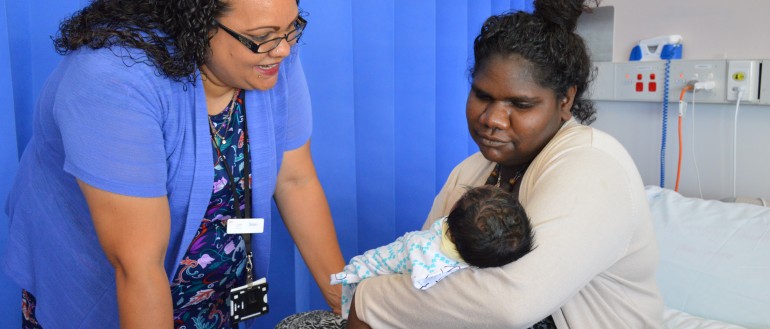Two significant diabetes papers were published recently, coinciding with World Diabetes Day in November.
The Youth-onset type 2 diabetes in the NT study found an alarmingly high prevalence of type 2 diabetes among Aboriginal and Torres Strait Islander youth in Australia’s north, which is likely the highest of any population of young people in the world, and ten times higher than any previous Australian estimate.
Of the four regions of northern Australia (the Top End, Central Australia, Kimberley, and Far North Queensland), the estimated prevalence was highest in Central Australia (14·4 cases per 1000 people aged 24 years or younger).
Study lead, Menzies PhD student and Royal Darwin Hospital (RDH), NT Health Paediatric Endocrinologist, Dr Angela Titmuss, said the findings raise serious concerns for the future health of young Aboriginal and Torres Strait Islander people.
“Only 14 per cent of young people in our study, defined as before the age of 25 years, had blood glucose levels within recommended targets. For those falling outside of the target, the risk of developing complications such as kidney damage at a young age is significantly increased,” Dr Titmuss said.
Of the 381 people aged 24 years or younger with type 2 diabetes in northern Australia, 68 per cent were female (n=258) and the youngest reported age at diagnosis was 4·4 years.
“This is the first study to use primary health care data as the basis of prevalence estimates which gives us confidence in the accuracy of the findings as it is primary health care services who usually look after these young people,” Dr Titmuss said.
Co-author, Menzies Senior Principal Research Fellow and RDH, NT Health Head of Endocrinology, Professor Louise Maple-Brown said that the data determined by the study is an important stage of the collaborative work already occurring across northern Australia between Aboriginal Community Controlled Health Services, government health services, Menzies and other agencies.
“This co-design study is important as it builds on the evidence required for us to work together with families and communities to further develop models of care that better meet the needs of young Aboriginal and Torres Strait Islander people with type 2 diabetes and improve their outcomes,” Prof Maple-Brown said.
“Developing type 2 diabetes at a young age has implications not only for the young person but for the future of their children, as babies exposed to high blood glucose levels during a pregnancy are at higher risk to develop type 2 diabetes at an even younger age than their mother, which would lead to even higher prevalence rates in the future.”
The study can be read in The Lancet Diabetes & Endocrinology. For further details on the co-design study visit Youth Diabetes - Diabetes across the Lifecourse
The Type 2 diabetes after a pregnancy with gestational diabetes among First Nations women in Australia: the PANDORA study, found Aboriginal women with gestational diabetes (GDM) are at an increased risk of developing type 2 diabetes within a short timeframe after pregnancy than non-Indigenous women.
The study highlighted the importance of access to diabetes prevention programs and in keeping with the theme ‘access to diabetes care’, which was a feature of this year’s World Diabetes Day.
Additionally, for Aboriginal women with GDM who proceeded to have diabetes postpartum, their risk markers for cardiovascular disease were higher than women who did not have GDM.
According to study lead, Dr Anna Wood, Menzies PhD student and Endocrinologist, Royal Darwin Hospital (RDH), this is the first prospective study on the cumulative incidence of type 2 diabetes among Aboriginal women after a pregnancy with GDM.
“Globally, the prevalence of GDM and type 2 diabetes is increasing, and we know that women with GDM are at a higher risk of developing type 2 diabetes after pregnancy,” Dr Wood said.
“We found that Aboriginal women with GDM had a very high rate of progression to type 2 diabetes (22 per cent) in a very short timeframe after pregnancy (2.5 years) in comparison to no non-Indigenous women developing diabetes in this timeframe."
Co-author, Menzies Senior Principal Research Fellow and Head of Department of Endocrinology, RDH, Professor Louise Maple-Brown says the study highlighted a need for policies on postpartum prevention of diabetes to be developed in partnership with Aboriginal women with GDM.
“The high progression to type 2 diabetes for Aboriginal women early in the postpartum period highlights the importance of early postpartum screening after GDM, prevention programs and a need for systems and social policy change to address food security, poverty, structural racism and other social and cultural determinants driving the diabetes epidemic,” Prof Maple-Brown said.
“Through our prospective observational birth cohort study, The Pregnancy and Neonatal Diabetes Outcomes in Remote Australia (PANDORA) study, we were in a unique position to follow women with and without diabetes in pregnancy. Thus we could assess their diabetes markers two and a half years postpartum as part of Wave 1 follow-up. In Wave 2, five years postpartum we will again be able to see the impact of GDM on diabetes diagnoses in the study cohort.”
The study can be read in the journal Diabetes Research and Clinical Practice. Click here for more information about the PANDORA study.
Photo: PANDORA research officer, Sian Graham with PANDORA study participant, Nataria-Ann O'Keefe and her baby Bill.

